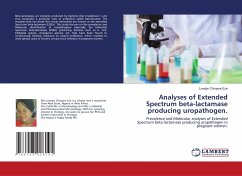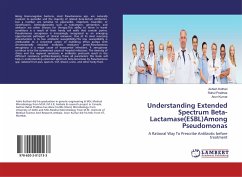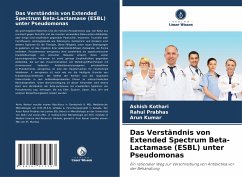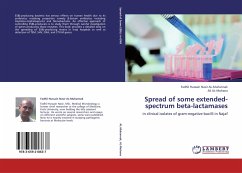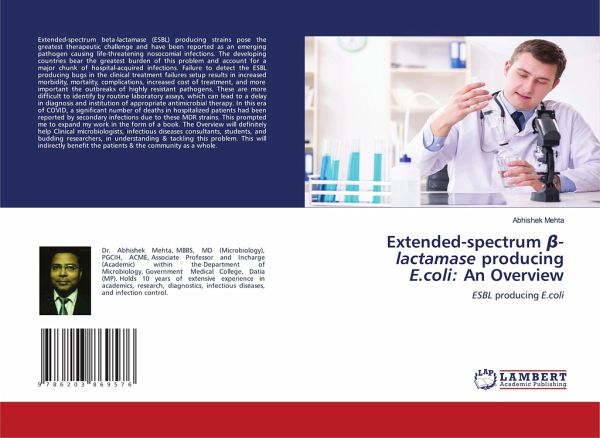
Extended-spectrum ¿-lactamase producing E.coli: An Overview
ESBL producing E.coli
Versandkostenfrei!
Versandfertig in 1-2 Wochen
26,99 €
inkl. MwSt.

PAYBACK Punkte
13 °P sammeln!
Extended-spectrum beta-lactamase (ESBL) producing strains pose the greatest therapeutic challenge and have been reported as an emerging pathogen causing life-threatening nosocomial infections. The developing countries bear the greatest burden of this problem and account for a major chunk of hospital-acquired infections. Failure to detect the ESBL producing bugs in the clinical treatment failures setup results in increased morbidity, mortality, complications, increased cost of treatment, and more important the outbreaks of highly resistant pathogens. These are more difficult to identify by rout...
Extended-spectrum beta-lactamase (ESBL) producing strains pose the greatest therapeutic challenge and have been reported as an emerging pathogen causing life-threatening nosocomial infections. The developing countries bear the greatest burden of this problem and account for a major chunk of hospital-acquired infections. Failure to detect the ESBL producing bugs in the clinical treatment failures setup results in increased morbidity, mortality, complications, increased cost of treatment, and more important the outbreaks of highly resistant pathogens. These are more difficult to identify by routine laboratory assays, which can lead to a delay in diagnosis and institution of appropriate antimicrobial therapy. In this era of COVID, a significant number of deaths in hospitalized patients had been reported by secondary infections due to these MDR strains. This prompted me to expand my work in the form of a book. The Overview will definitely help Clinical microbiologists, infectious diseases consultants, students, and budding researchers, in understanding & tackling this problem. This will indirectly benefit the patients & the community as a whole.Extended-spectrum beta-lactamase (ESBL) producing strains pose the greatest therapeutic challenge and have been reported as an emerging pathogen causing life-threatening nosocomial infections. The developing countries bear the greatest burden of this problem and account for a major chunk of hospital-acquired infections. Failure to detect the ESBL producing bugs in the clinical treatment failures setup results in increased morbidity, mortality, complications, increased cost of treatment, and more important the outbreaks of highly resistant pathogens. These are more difficult to identify by routine laboratory assays, which can lead to a delay in diagnosis and institution of appropriate antimicrobial therapy. In this era of COVID, a significant number of deaths in hospitalized patients had been reported by secondary infections due to these MDR strains. This prompted me to expand my work in the form of a book. The Overview will definitely help Clinical microbiologists, infectious diseases consultants, students, and budding researchers, in understanding & tackling this problem. This will indirectly benefit the patients & the community as a whole.



